HONDA CIVIC COUPE 1999 Service Manual
Manufacturer: HONDA, Model Year: 1999, Model line: CIVIC COUPE, Model: HONDA CIVIC COUPE 1999Pages: 269, PDF Size: 2.42 MB
Page 41 of 269
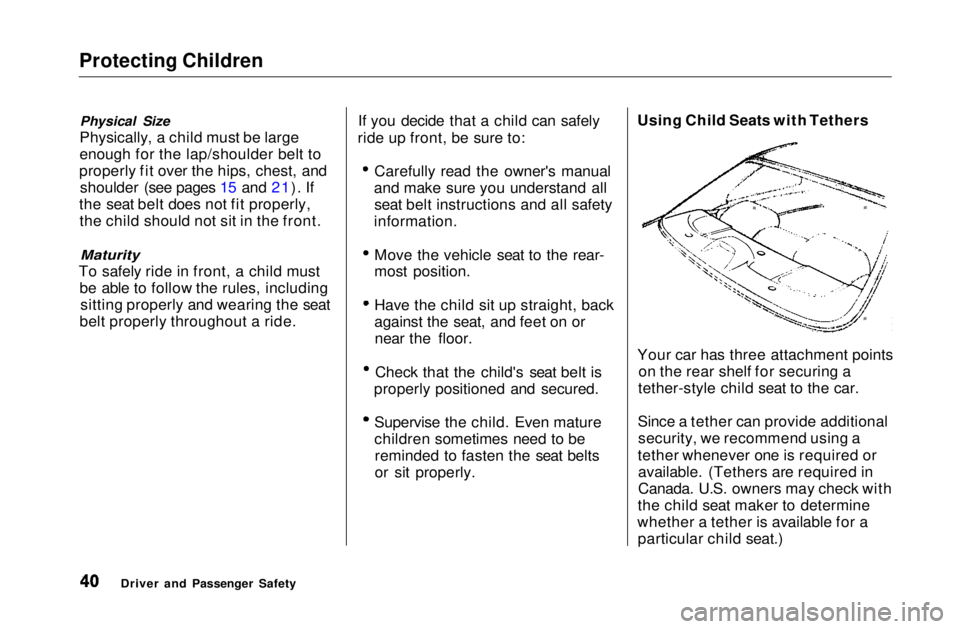
Protecting Children
Physical Size
Physically, a child must be large
enough for the lap/shoulder belt to
properly fit over the hips, chest, and shoulder (see pages 15 and 21). If
the seat belt does not fit properly, the child should not sit in the front.
Maturity
To safely ride in front, a child must be able to follow the rules, includingsitting properly and wearing the seat
belt properly throughout a ride. If you decide that a child can safely
ride up front, be sure to: Carefully read the owner's manual
and make sure you understand all seat belt instructions and all safety
information. Move the vehicle seat to the rear-
most position.
Have the child sit up straight, back
against the seat, and feet on or
near the floor. Check that the child's seat belt is
properly positioned and secured. Supervise the child. Even mature
children sometimes need to be
reminded to fasten the seat belts
or sit properly. Using Child Seats with Tethers
Your car has three attachment points
on the rear shelf for securing a
tether-style child seat to the car.
Since a tether can provide additional security, we recommend using a
tether whenever one is required or available. (Tethers are required in
Canada. U.S. owners may check with
the child seat maker to determine
whether a tether is available for a particular child seat.)
Driver and Passenger SafetyMain Menu Table of Contents s t
Page 42 of 269
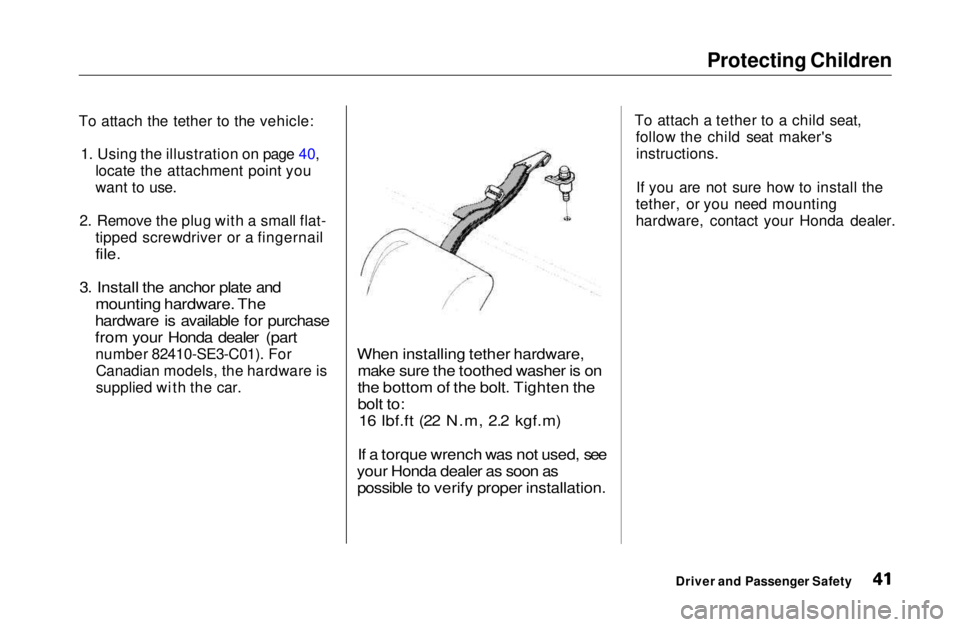
Protecting Children
To attach the tether to the vehicle: 1. Using the illustration on page 40, locate the attachment point you
want to use.
2. Remove the plug with a small flat- tipped screwdriver or a fingernail
file.
3. Install the anchor plate and
mounting hardware. The
hardware is available for purchase
from your Honda dealer (part
number 82410-SE3-C01). ForCanadian models, the hardware is
supplied with the car.
When installing tether hardware,
make sure the toothed washer is on
the bottom of the bolt. Tighten the
bolt to: 16 lbf.ft (22 N.m, 2.2 kgf.m)
If a torque wrench was not used, see
your Honda dealer as soon as possible to verify proper installation.
To attach a tether to a child seat,
follow the child seat maker'sinstructions.
If you are not sure how to install the
tether, or you need mounting
hardware, contact your Honda dealer.
Driver and Passenger SafetyMain Menu Table of Contents s t
Page 43 of 269
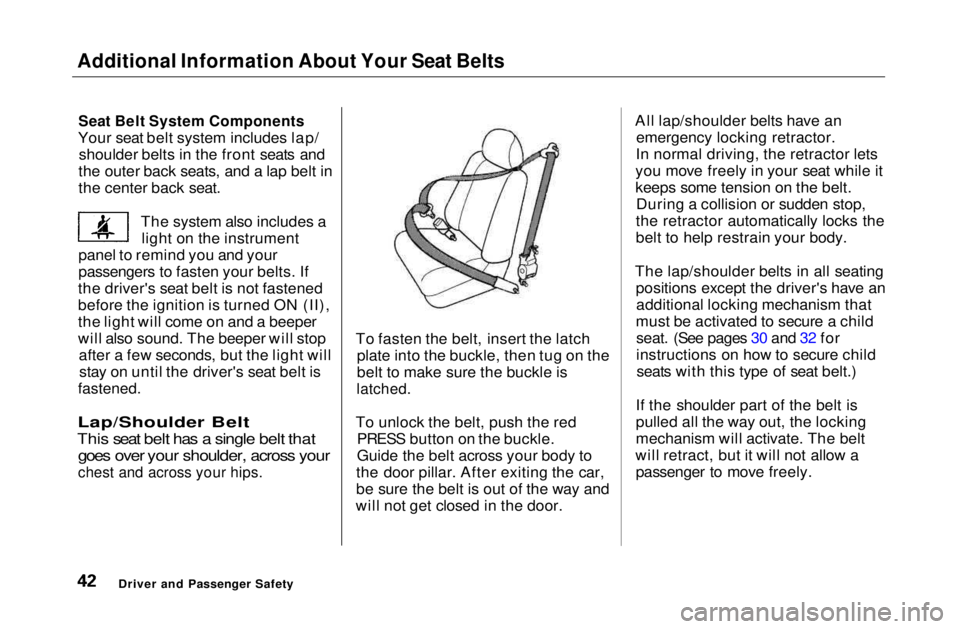
Additional Information About Your Seat Belts
Seat Belt System Components
Your seat belt system includes lap/ shoulder belts in the front seats and
the outer back seats, and a lap belt in
the center back seat.
The system also includes alight on the instrument
panel to remind you and your
passengers to fasten your belts. If
the driver's seat belt is not fastened
before the ignition is turned ON (II),
the light will come on and a beeper
will also sound. The beeper will stop after a few seconds, but the light willstay on until the driver's seat belt is
fastened.
Lap/Shoulder Belt
This sea t
belt has a single belt that
goes over your shoulder, across your
chest and across your hips.
To fasten the belt, insert the latch
plate into the buckle, then tug on the
belt to make sure the buckle is
latched.
To unlock the belt, push the red PRESS button on the buckle.
Guide the belt across your body to
the door pillar. After exiting the car,
be sure the belt is out of the way and
will not get closed in the door. All lap/shoulder belts have an
emergency locking retractor.
In normal driving, the retractor lets
you move freely in your seat while it
keeps some tension on the belt. During a collision or sudden stop,
the retractor automatically locks the
belt to help restrain your body.
The lap/shoulder belts in all seating positions except the driver's have anadditional locking mechanism that
must be activated to secure a child seat. (See pages 30 and 32 for
instructions on how to secure childseats with this type of seat belt.)
If the shoulder part of the belt is
pulled all the way out, the locking
mechanism will activate. The belt
will retract, but it will not allow a passenger to move freely.
Driver and Passenger SafetyMain Menu Table of Contents s t
Page 44 of 269
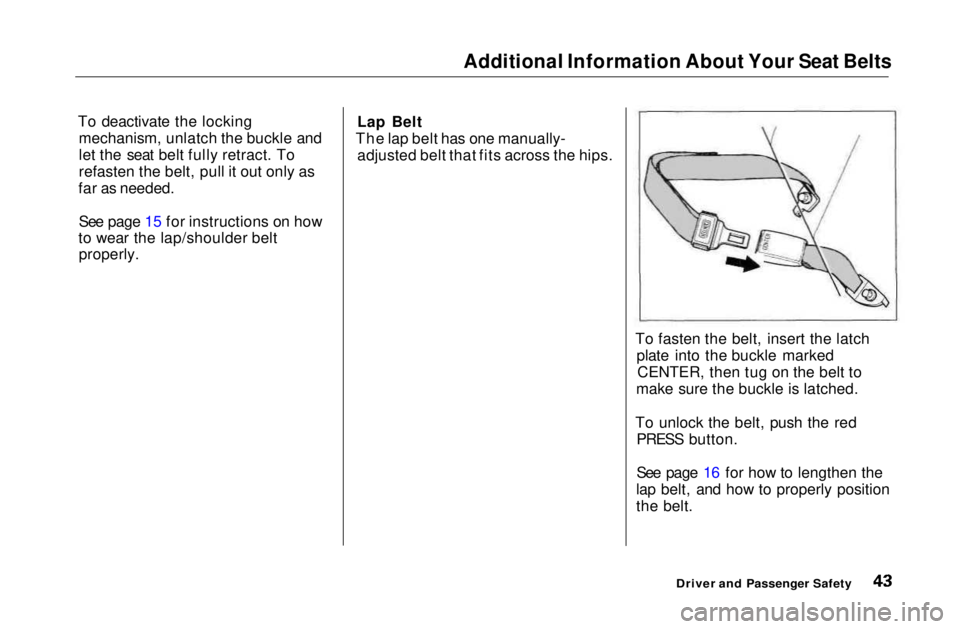
Additional Information About Your Seat Belts
To deactivate the locking mechanism, unlatch the buckle and
let the seat belt fully retract. To
refasten the belt, pull it out only as
far as needed.
See page 15 for instructions on how
to wear the lap/shoulder belt properly. Lap Belt
The lap belt has one manually- adjusted belt that fits across the hips.
To fasten the belt, insert the latchplate into the buckle markedCENTER, then tug on the belt to
make sure the buckle is latched.
To unlock the belt, push the red PRESS button.
See page 16 for how to lengthen the
lap belt, and how to properly position
the belt.
Driver and Passenger SafetyMain Menu Table of Contents s t
Page 45 of 269
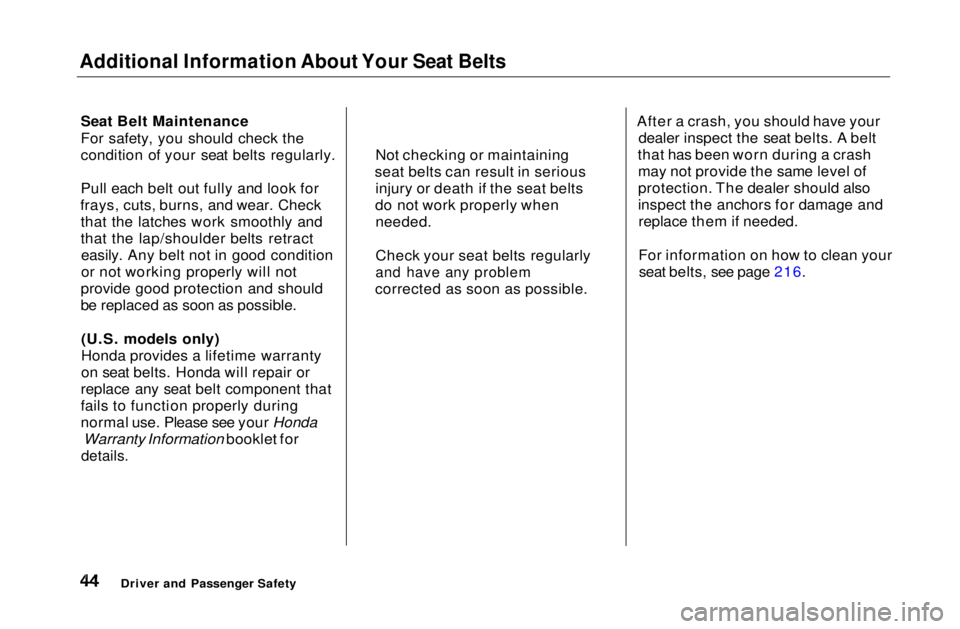
Additional Information About Your Seat Belts
Seat Belt Maintenance
For safety, you should check the
condition of your seat belts regularly.
Pull each belt out fully and look for
frays, cuts, burns, and wear. Check that the latches work smoothly and
that the lap/shoulder belts retracteasily. Any belt not in good condition
or not working properly will not
provide good protection and should
be replaced as soon as possible.
(U.S. models only)
Honda provides a lifetime warranty
on seat belts. Honda will repair or
replace any seat belt component that
fails to function properly during
normal use. Please see your Honda
Warranty Information booklet for
details.
After a crash, you should have your
dealer inspect the seat belts. A belt
that has been worn during a crash may not provide the same level of
protection. The dealer should also
inspect the anchors for damage andreplace them if needed.
For information on how to clean yourseat belts, see page 216.
Driver and Passenger Safety Not checking or maintaining
seat belts can result in serious injury or death if the seat belts
do not work properly when needed.
Check your seat belts regularly
and have any problem
corrected as soon as possible.Main Menu Table of Contents s t
Page 46 of 269
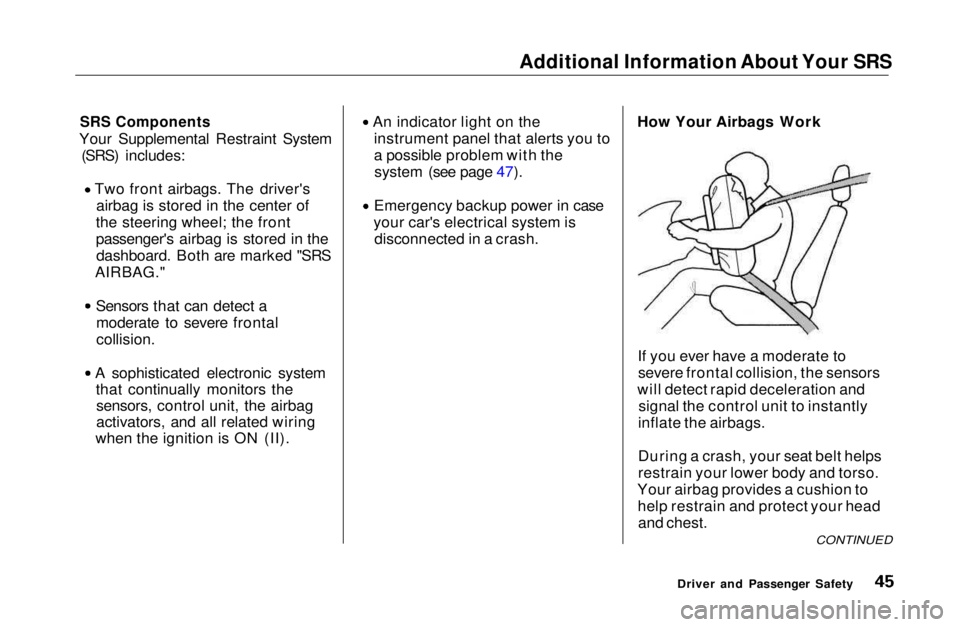
Additional Information About Your SRS
SRS Components
Your Supplemental Restraint System (SRS) includes: Two front airbags. The driver's
airbag is stored in the center of
the steering wheel; the front
passenger's airbag is stored in the dashboard. Both are marked "SRS
AIRBAG." Sensors that can detect a
moderate to severe frontal
collision. A sophisticated electronic system
that continually monitors thesensors, control unit, the airbag
activators, and all related wiring
when the ignition is ON (II). An indicator light on the
instrument panel that alerts you to
a possible problem with thesystem (see page 47). Emergency backup power in case
your car's electrical system is disconnected in a crash. How Your Airbags Work
If you ever have a moderate tosevere frontal collision, the sensors
will detect rapid deceleration and signal the control unit to instantly
inflate the airbags.
During a crash, your seat belt helps
restrain your lower body and torso.
Your airbag provides a cushion to help restrain and protect your headand chest.
Driver and Passenger Safety
CONTINUEDMain Menu Table of Contents s t
Page 47 of 269
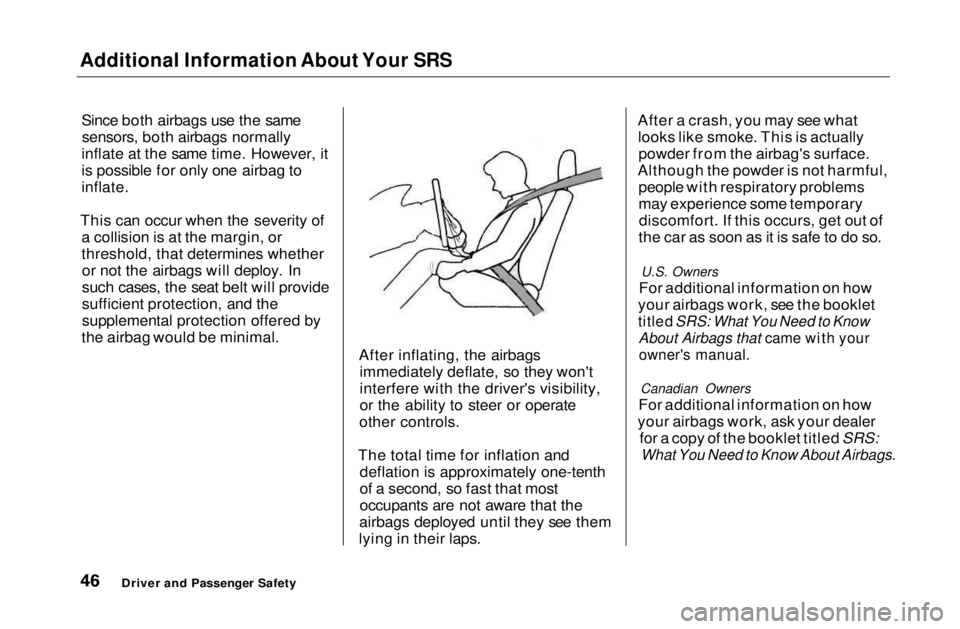
Additional Information About Your SRS
Since both airbags use the samesensors, both airbags normally
inflate at the same time. However, it
is possible for only one airbag to
inflate.
This can occur when the severity of a collision is at the margin, or
threshold, that determines whetheror not the airbags will deploy. In
such cases, the seat belt will provide
sufficient protection, and the
supplemental protection offered by
the airbag would be minimal.
After inflating, the airbagsimmediately deflate, so they won't
interfere with the driver's visibility,
or the ability to steer or operate
other controls.
The total time for inflation and deflation is approximately one-tenth
of a second, so fast that most
occupants are not aware that the
airbags deployed until they see them
lying in their laps. After a crash, you may see what
looks like smoke. This is actuallypowder from the airbag's surface.
Although the powder is not harmful, people with respiratory problems
may experience some temporarydiscomfort. If this occurs, get out of
the car as soon as it is safe to do so.
U.S. Owners
For additional information on how
your airbags work, see the booklet
titled SRS: What You Need to Know About Airbags that came with your
owner's manual.
Canadian Owners
For additional information on how
your airbags work, ask your dealer for a copy of the booklet titled SRS:
What You Need to Know About Airbags.
Driver and Passenger SafetyMain Menu Table of Contents s t
Page 48 of 269
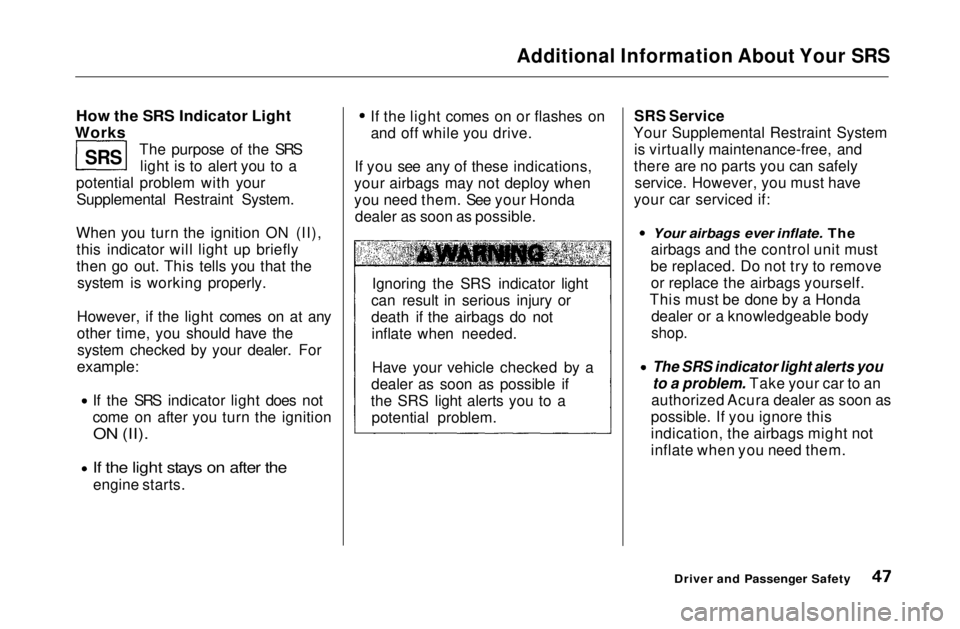
Additional Information About Your SRS
How the SRS Indicator Light
Works
The purpose of the SRSlight is to alert you to a
potential problem with your Supplemental Restraint System.
When you turn the ignition ON (II), this indicator will light up briefly
then go out. This tells you that the system is working properly.
However, if the light comes on at any
other time, you should have the system checked by your dealer. For
example:
If the SRS indicator light does not
come on after you turn the ignition
ON (II). If the light stays on after the
engine starts. If the light comes on or flashes on
and off while you drive.
If you see any of these indications,
your airbags may not deploy when
you need them. See your Honda dealer as soon as possible. SRS Service
Your Supplemental Restraint System is virtually maintenance-free, and
there are no parts you can safely service. However, you must have
your car serviced if:
Your airbags ever inflate. The
airbags and the control unit must
be replaced. Do not try to remove or replace the airbags yourself.
This must be done by a Honda dealer or a knowledgeable body
shop.
The SRS indicator light alerts you
to a problem. Take your car to an
authorized Acura dealer as soon as
possible. If you ignore this
indication, the airbags might not
inflate when you need them.
Driver and Passenger Safety
SRS
Ignoring the SRS indicator light
can result in serious injury or
death if the airbags do not inflate when needed.
Have your vehicle checked by a
dealer as soon as possible if
the SRS light alerts you to a potential problem.Main Menu Table of Contents s t
Page 49 of 269
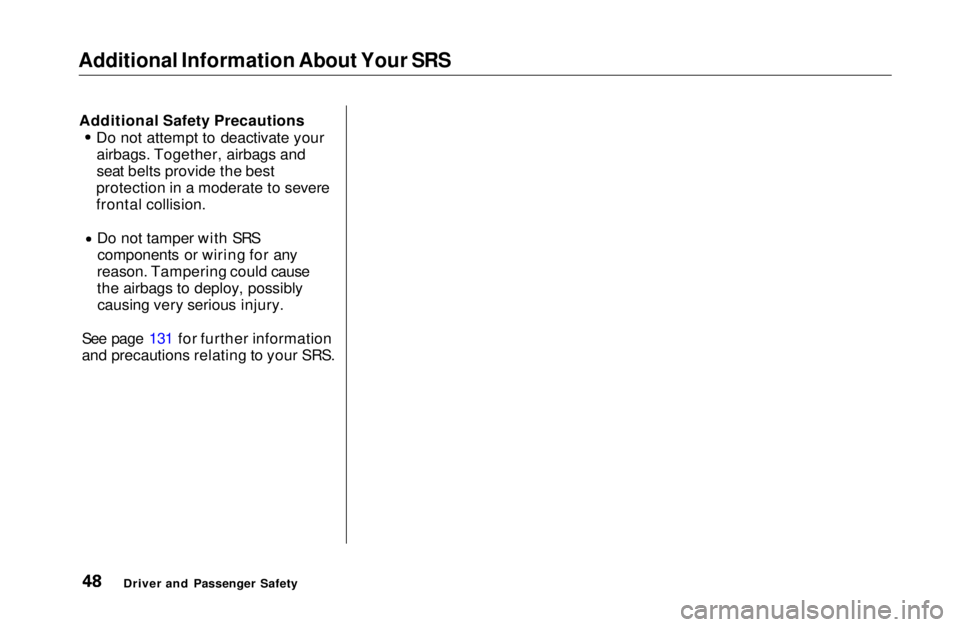
Additional Information About Your SRS
Additional Safety Precautions Do not attempt to deactivate your
airbags. Together, airbags and
seat belts provide the best
protection in a moderate to severe
frontal collision. Do not tamper with SRS
components or wiring for any
reason. Tampering could cause
the airbags to deploy, possibly causing very serious injury.
See page 131 for further information
and precautions relating to your SRS.
Driver and Passenger SafetyMain Menu Table of Contents s t
Page 50 of 269
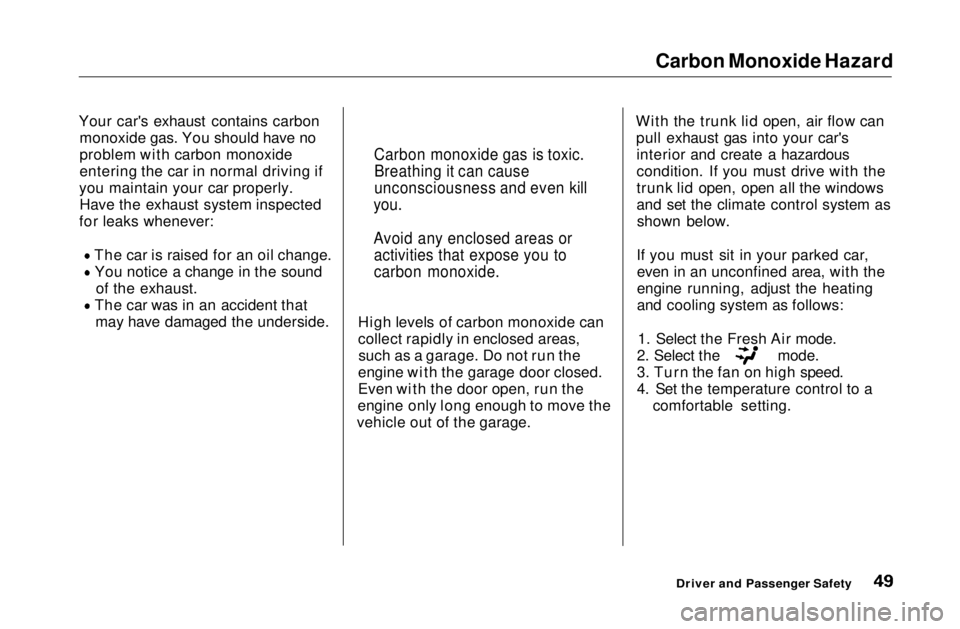
Carbon Monoxide Hazard
Your car's exhaust contains carbon monoxide gas. You should have no
problem with carbon monoxide
entering the car in normal driving if
you maintain your car properly. Have the exhaust system inspected
for leaks whenever:
The car is raised for an oil change.You notice a change in the sound of the exhaust. The car was in an accident that
may have damaged the underside.
High levels of carbon monoxide can
collect rapidly in enclosed areas,
such as a garage. Do not run the
engine with the garage door closed.
Even with the door open, run the
engine only long enough to move the
vehicle out of the garage. With the trunk lid open, air flow can
pull exhaust gas into your car'sinterior and create a hazardous
condition. If you must drive with the
trunk lid open, open all the windows
and set the climate control system asshown below.
If you must sit in your parked car, even in an unconfined area, with the
engine running, adjust the heating
and cooling system as follows:
1. Select the Fresh Air mode. 2. Select the mode.
3. Turn the fan on high speed.
4. Set the temperature control to a
comfortable setting.
Driver and Passenger Safety
Carbon monoxide gas is toxic.
Breathing it can cause
unconsciousness and even kill
you.
Avoid any enclosed areas or activities that expose you to
carbon monoxide.Main Menu Table of Contents s t